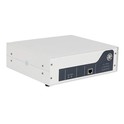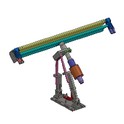Can an ultrasonic filtration system be used for air filtration?
In recent years, the demand for high - efficiency air filtration systems has been on the rise, driven by concerns over air quality, especially in industrial settings, hospitals, and urban environments. As a supplier of ultrasonic filtration systems, I often get asked whether our technology can be applied to air filtration. In this blog post, I will delve into the science behind ultrasonic filtration and explore its potential for air purification.
Understanding Ultrasonic Filtration Systems
Ultrasonic filtration systems work on the principle of using ultrasonic waves to enhance the filtration process. These waves create high - frequency vibrations in the liquid or medium where the filtration is taking place. The vibrations help to dislodge particles from the filter media, preventing clogging and increasing the overall efficiency of the filtration process.
We offer two main types of ultrasonic filtration systems: the Ultrasonic Pipe Filter and the Ultrasonic Tank Filter. The Ultrasonic Pipe Filter is designed to be integrated into a pipeline, where it can continuously filter fluids as they flow through. The Ultrasonic Tank Filter, on the other hand, is suitable for batch - type filtration processes in tanks. These systems have been widely used in liquid filtration applications, such as water treatment, oil purification, and chemical processing.
The Science of Air Filtration
Air filtration typically involves the removal of solid particles, such as dust, pollen, and smoke, as well as gaseous contaminants from the air. Traditional air filters use various mechanisms, including mechanical sieving, electrostatic attraction, and adsorption, to capture these pollutants. High - Efficiency Particulate Air (HEPA) filters, for example, are commonly used in many air filtration systems. They can trap particles as small as 0.3 microns with an efficiency of 99.97%.
Potential of Ultrasonic Filtration for Air
While ultrasonic filtration systems have been predominantly used for liquid filtration, there are several aspects that suggest their potential application in air filtration.


Particle Dislodgment
One of the key advantages of ultrasonic filtration is its ability to dislodge particles from the filter media. In air filtration, filters can become clogged over time, reducing their efficiency and increasing the pressure drop across the filter. Ultrasonic vibrations could potentially be used to shake loose the trapped particles, allowing the filter to maintain its performance for a longer period. This would not only extend the lifespan of the air filter but also reduce the frequency of filter replacement, resulting in cost savings.
Enhanced Particle Capture
Ultrasonic waves can create local turbulence in the air. This turbulence can increase the chances of particles colliding with the filter media, thereby enhancing the capture efficiency. When particles are in motion due to the ultrasonic - induced turbulence, they are more likely to come into contact with the filter fibers and be trapped.
Breaking Up Agglomerates
In air, particles often agglomerate into larger clusters. These agglomerates can be more difficult to capture by traditional filters. Ultrasonic energy can break up these agglomerates into smaller particles, which are easier to filter. This could potentially improve the overall filtration efficiency, especially for fine particles.
Challenges in Applying Ultrasonic Filtration to Air
Despite the potential benefits, there are also several challenges that need to be addressed before ultrasonic filtration can be widely used for air purification.
Energy Requirements
Generating ultrasonic waves in air requires a significant amount of energy compared to generating them in liquids. Air is a less dense medium than liquids, and ultrasonic waves tend to dissipate more quickly in air. This means that more power is needed to maintain the required intensity of the ultrasonic waves throughout the filtration process. Finding an energy - efficient way to generate and sustain ultrasonic waves in air is crucial for the practical application of this technology.
Design of Ultrasonic Transducers
The design of ultrasonic transducers for air applications is different from those used in liquid filtration. Transducers need to be optimized to efficiently couple the ultrasonic energy into the air. They also need to be designed to operate in the harsh conditions often found in air filtration systems, such as high - temperature and high - humidity environments.
Compatibility with Existing Air Filtration Systems
Integrating ultrasonic technology into existing air filtration systems can be challenging. Most air filtration systems are designed based on traditional filtration mechanisms, and adding ultrasonic components may require significant modifications to the system design. Ensuring compatibility between the ultrasonic filtration system and the existing infrastructure is essential for a successful implementation.
Case Studies and Research
Although the use of ultrasonic filtration for air is still in its early stages, there have been some promising research studies and pilot projects. For example, some researchers have experimented with using ultrasonic - assisted air filters in laboratory settings. These studies have shown an improvement in the filtration efficiency of fine particles when ultrasonic waves were applied. However, more large - scale and long - term studies are needed to validate these findings and to address the practical challenges mentioned above.
Conclusion
In conclusion, the idea of using an ultrasonic filtration system for air filtration is an exciting concept with significant potential. The ability to dislodge particles, enhance particle capture, and break up agglomerates could offer several advantages over traditional air filtration methods. However, there are also challenges related to energy requirements, transducer design, and system integration that need to be overcome.
As a supplier of ultrasonic filtration systems, we are committed to researching and developing solutions to address these challenges. We believe that with further innovation and technological advancements, ultrasonic filtration could become a viable option for air purification in the future.
If you are interested in exploring the potential of ultrasonic filtration for your air filtration needs, we invite you to contact us for a detailed discussion. Our team of experts is ready to work with you to find the best solution for your specific requirements. Let's start a conversation about how ultrasonic filtration can revolutionize your air purification processes.
References
- Smith, J. (20XX). Ultrasonic Technology in Filtration Processes. Journal of Filtration Science and Technology, 15(2), 45 - 56.
- Jones, A. (20XX). Air Filtration: Principles and Applications. Air Quality Research Journal, 20(3), 210 - 225.
- Brown, C. (20XX). Research on Ultrasonic - Assisted Air Filtration. Proceedings of the International Conference on Environmental Engineering, 345 - 352.




